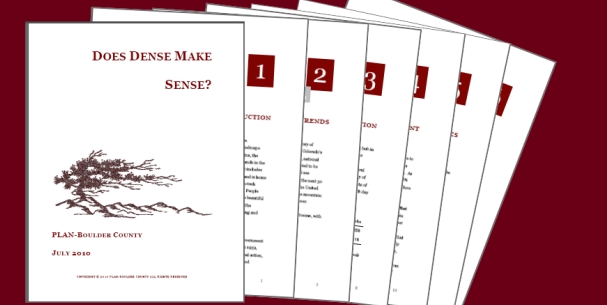Editor’s note: PLAN-Boulder County has issued a report entitled Does Dense Make Sense? This is the final part in a six part series extracted from the report.
PLAN-Boulder County believes that Boulder County is a special place. Our beautiful mountain backdrop overlooking verdant plains has been protected forever with progressive land use planning. Our extensive trail network and recreational facilities, coupled with 300 days of sunshine a year, invite residents to explore and appreciate our natural surroundings. Our transportation system offers alternatives to driving a car through comprehensive bicycle facilities and transit services. A vibrant cultural and intellectual community exists through the University of Colorado and numerous federal laboratories. Our environmental stewardship and commitment to sustainability is recognized and emulated all over the world. We believe that Boulder County is a unique and beautiful place that is worth caring about, and a place that is worth protecting.
We also believe that maintaining our quality of life in Boulder County will require careful management from committed municipal staff, engaged citizens and inspired leaders. Legend has it that Chief Niwot, leader of the South Arapaho tribe in the Boulder area in the mid-1800’s, told the people seeking gold in the area that “People seeing the beauty of this valley will want to stay and their staying will be the undoing of the beauty.”
In the past, the City of Boulder and Boulder County have done many things right to guide development and protect the environment. The most inspired and visionary measures have been:
- Creating urban growth boundaries through Open Space purchases around our cities
- Adopting the Super IGA (intergovernmental agreement) that restricts sprawl around Boulder County cities
- Requiring new buildings to be built to strict energy efficiency codes through the Green Points and BuildSmart programs
- Limiting the height of buildings to an absolute maximum of 55 feet (City of Boulder)
- Limiting our residential growth rate to less than 1% (City of Boulder)
While these actions have helped create the quality of life that our citizens love, increasing development pressures in our community now require additional attention to directing development. As we move forward, Boulder and other Boulder County cities should direct slow, careful, measured growth to infill and redevelopment sites within the context of height and growth-rate limits. PLAN-Boulder County recommends that all new development in Boulder County adhere to these four pillars.
Pillar I: Provide Alternative Transportation
Alternative transportation is an integral component of regional growth as all communities in Boulder County experience heavy daily in and out commuting. Boulder County municipalities should require minimum levels of transit service between jurisdictions, such as 15-minute peak service and 30-minute off-peak service. Final mile consideration should be implemented to ensure transit stops are within walking, biking, or shuttle distances of job centers and other destinations. Boulder County communities should develop funding sources to provide Eco Passes to all employees within the county. Ridesharing programs should be expanded to fill empty seats in single occupancy vehicles. Finally, municipalities should reduce parking requirements or create parking maximums for all new development, and implement managed parking zones in transit-rich central areas.
Pillar II: Reduce Greenhouse Gas Generation in New Development
Densification in appropriate areas of our cities offers a potential reduction in vehicle miles traveled of about 10% and energy efficiency increases as high as 20-40% for those new developments. Thus, we can expect dense developments to produce approximately 30-50% less GHG emissions than similarly constructed, detached housing in suburban settings. However, population growth, even in well-designed dense areas, will grow our carbon footprint significantly. For example, doubling population by densifying an area will magnify GHG emissions by 150% to 170%.
Buildings should be built to progressively decreasing energy consumption levels (including embodied energy), and should be powered entirely by renewable energy sources. The external or indirect costs of provisioning dense areas should be considered. Smaller house sizes, built to be durable, must also be part of the solution.
Pillar III: Create an Adequate Public Services Ordinance
The current development impact fees in all municipalities in Boulder County are inadequate and leave residential development as a net tax drain on city budgets. The municipalities within Boulder County should pass impact fees, excise taxes and/or Adequate Public Facilities ordinances to ensure that current levels of public services (education, parks, libraries, transportation, police/fire, etc.) are maintained and not degraded by the impacts of growth. We recommend that that these charges are set high enough that municipalities can provide good public services without relying on commercial sales taxes to balance budgets.
Pillar IV: Create Housing Diversity
As Boulder rapidly approaches buildout, it is important that the City develop methods of creating affordable housing that do not rely as heavily on new development.
Inclusionary zoning is still an important tool, but the current program must change. At a minimum, two changes are essential to achieve affordability goals. First, cash-in-lieu for off-site provision of affordable units must be equivalent to the actual cost of building or acquiring those units. Second, if development intensity potential of properties is increased through upzoning or exceptions to development limits, then increased numbers of affordable units must be obtained. Exceptions to development limits must only be granted when something exceptional is provided in return. Otherwise, development intensity increases create windfalls for property owners and are, in essence, a public subsidy for the developer. These windfalls are conferred by the Public and must therefore be recaptured in full, for the purpose they were granted – a public benefit.
Finally, regional housing choice is still poorly understood. Boulder County cities should conduct comprehensive studies to understand both the demographics and income ranges of our local work forces, the corresponding housing requirements and appropriate affordable housing goals, and potential funding sources to create additional affordable housing.



